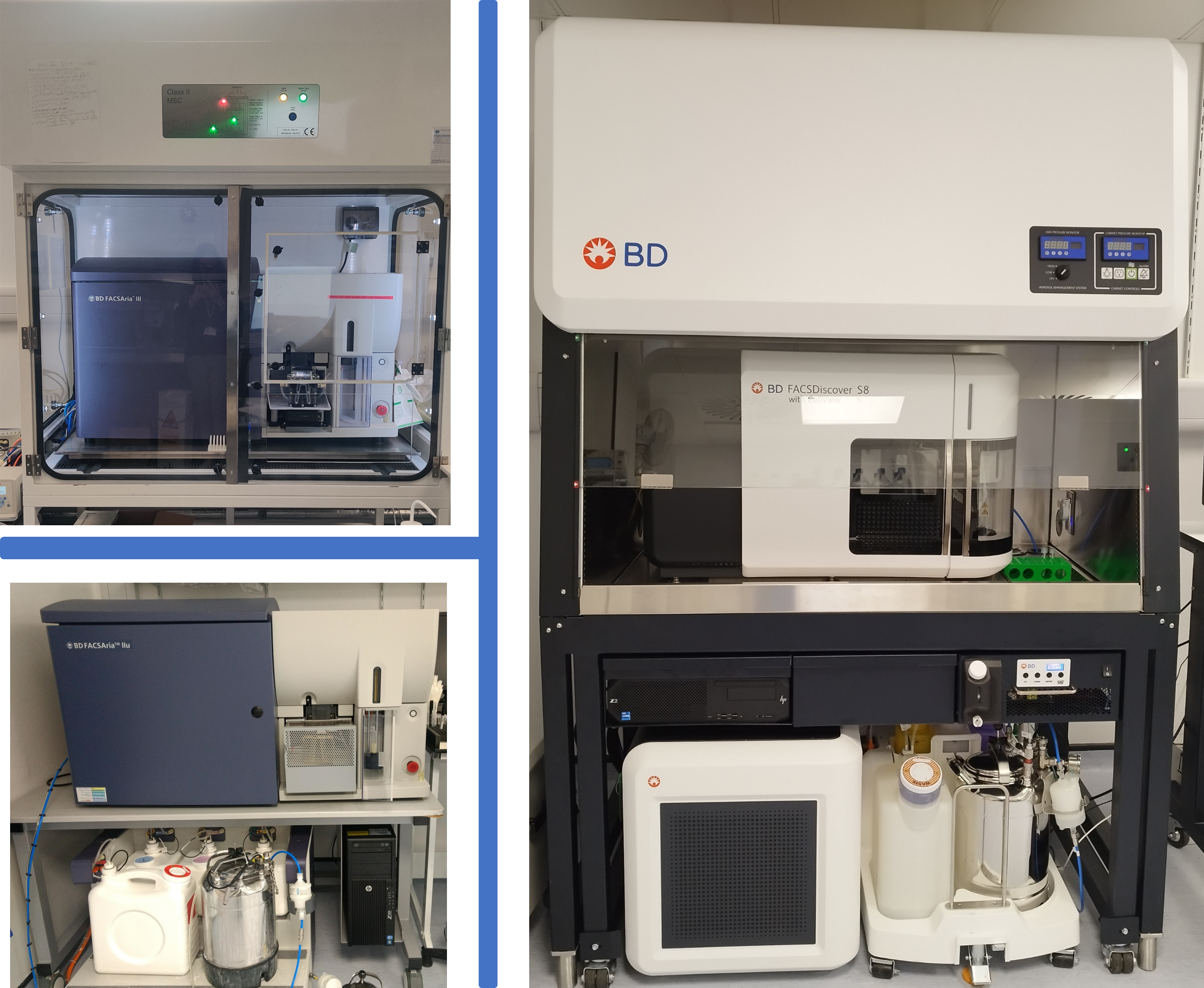
Instruments:
Cell sorters:
- BD FACS Discover S8 with CellView technology
- BD Aria III
- BD Aria IIu
Analysers:
- Two Aurora Spectral Analysers (Aurora A and Aurora B)
- CytoFLEX LX
- CytoFLEX S
- Attune NxT
We welcome enquiries regarding possible use.
The configurations of all instruments are available upon request or for registered users on PPMS.
Cell sorters
The cell sorters are mainly operated by staff from the facility as per researchers’ instructions. High-end users that need to sort frequently and/or after core hours can also be trained to use the FACSArias independently.
FACSDiscover S8 with CellView technology
The Discover S8 combines full spectral flow cytometry with real-time spatial and morphological measurements, enabling the sorting of cell types that could previously not be identified or isolated. One major consequence of this transformational advance is that cells can be sorted not only on the proteins that they express but also according to the location of protein expression in the cell. This is the first instrument in the market capable of separating cells based on their imaging output.
The S8 has five lasers (349, 405, 488, 561 and 637nm) and 78 algorithmically optimised fluorescent APDs covering the full spectrum. The entire emission spectrum of each fluorochrome is captured across the different modules and then stitched together to create a spectral signature that combines emission information from all five excitation wavelengths.
The Image technology called CellView makes it possible to produce images without a camera, enabling imaging at real-time speed required for sorting. It is possible to sort based on these imaging parameters and combine them with traditional fluorescent parameters. The image module uses the blue laser (488nm excitation) and produces 3 scatter parameters (FSC, SSC and lightloss) and 3 fluorescent parameters comparable to 10x to 20x magnification on a microscope: GFP-like, PE-like, and PECy7-like. It is now possible to measure imaging features like Eccentricity (how round a particle is), Diffusivity (how concentrated a signal is), correlation (how much overlap between 2 fluorochromes), among others.
More information about the FACSDiscover S8 with CellView technology.
Short video of the CellView technology.
Aria III
The Aria III has four lasers (405, 488, 561 and 633nm), 16 fluorescent detectors, and two scatters. The Aria III is also contained within a class II biohazardous cabinet and can be used to sort CLASS I and II samples. The Aria can also sort cells in bulk (up to 4 populations simultaneously) or into multiwell trays or slides.
Aria Ilu
The Aria IIu has three lasers (405, 488 and 633nm), nine fluorescent detectors and two scatters. The Aria is not contained in a biohazard cabinet and can only be used with CLASS I samples. The Aria can also sort cells in bulk (up to 4 populations simultaneously) or into multiwell trays or slides.
Analysers
The analyzers are user-operated, but all users require at least one training session before being used independently. Training sessions should be requested on PPMS.
Cytek Auroras
The Cytek Auroras are different from conventional flow cytometers because they measure the full spectral output excited by each laser and deconvolute signals according to prerecorded fluorochrome characteristics. This means it is easier for you to run many different fluorescent probes, including ones previously too similar to use in combination (though they still need to be different spectrally to some degree). The Auroras have five lasers at 488nm (blue), 561nm (yellow-green), 633nm (red), 355nm (UV), and 405nm (violet) and 64 fluorescent APDs covering the full spectrum. Both Auroras also have a plate reader capable of running samples from standard 96-well plates. The loader on Aurora B can also run deep-well plates and it has a 40-tube rack for 5mL round-bottom tubes.
More information about the spectral analysis
Attune NxT
The Attune NxT is equipped with four lasers (488nm (blue), 637nm (red), 405nm (violet), and 561nm (yellow-green)) and is capable of detecting 16 parameters (FSC, SSC, and 14 fluorescent parameters). Equipped with an autosampler compatible with many different plate formats, including 96-well, 384-well, and deep-well plates. The Attune is equipped with acoustic-assisted hydrodynamic focusing and can achieve sample-throughput rates up to 10 times faster than traditional cytometers. This means you can process samples more quickly and acquire sufficient events even from very dilute samples. In addition, it accommodates no-wash, no-lyse protocols, allowing you to run whole blood without lysis.
The Attune NxT is our only analyser in a containment level 2 room and users can run Hazard Group 2 samples (users must submit a risk assessment prior to the experiments).
More information about acoustic focusing
CytoFLEX S
The CytoFLEX S is equipped with four lasers (488nm (blue), 640nm (red), 405nm (violet), and 561nm (yellow-green) and is capable of detecting 15 parameters (FSC, SSC, and 13 fluorescent parameters). It can run samples from 96-well plates. The CytoFLEX S is designed to be user-friendly, and users should be able to run it independently after a training session with a member of the facility staff.
More information about the Cytoflex S
CytoFLEX LX
The CytoFLEX LX is equipped with five lasers, 488nm (blue), 638nm (red), 405nm (violet), 561nm (yellow-green), and 35nm (UV), and is capable of detecting 21 parameters (FSC, SSC, and 19 fluorescent parameters). It can run samples from 96-well plates. The CytoFLEX LX is designed to be user-friendly, and users should be able to run it independently after a training session with a member of the facility staff. Having a UV laser, it is the ideal instrument for running calcium flux experiments using Indo-1.
More information about the CytoFlex LX
Data Analysis
We also provide, free of charge, two stand-alone computer workstations for flow data analysis for facility users. Both PCs run FlowJo. Other available software: Kaluza, Attune NxT, SpectroFlo, CytExpert.

